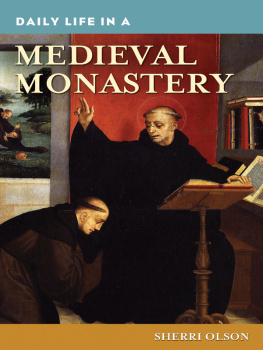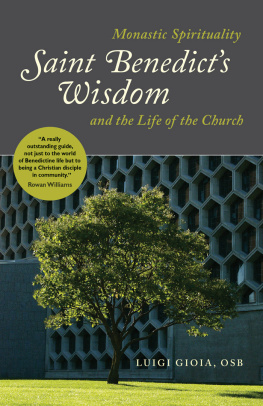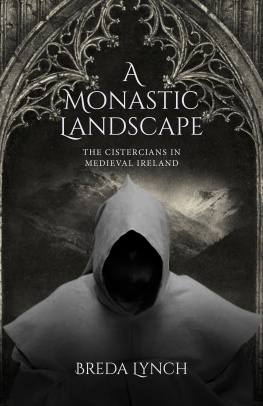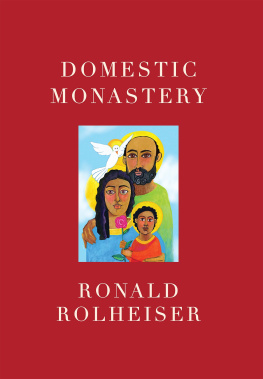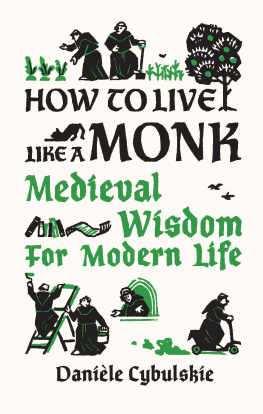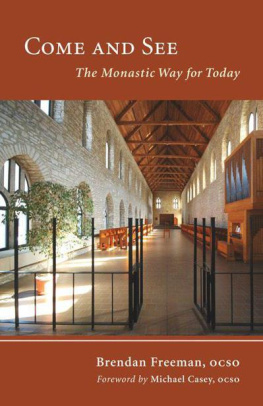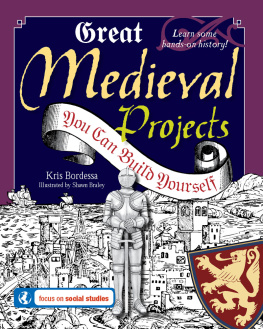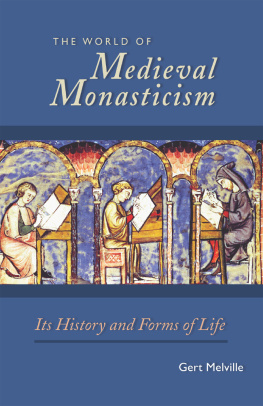
DAILY LIFE IN A
MEDIEVAL MONASTERY
Recent Titles in
The Greenwood Press Daily Life Through History Series
The Aztecs, Second Edition
Davd Carrasco and Scott Sessions
The Progressive Era
Steven L. Piott
Women during the Civil Rights Era
Danelle Moon
Colonial Latin America
Ann Jefferson and Paul Lokken
The Ottoman Empire
Mehrdad Kia
Pirates
David F. Marley
Arab Americans in the 21st Century
Anan Ameri and Holly Arida, Editors
African American Migrations
Kimberley L. Phillips
The Salem Witch Trials
K. David Goss
Behind the Iron Curtain
Jim Willis
Trade: Buying and Selling in World History
James M. Anderson
The Colonial South
John Schlotterbeck
DAILY LIFE IN A
MEDIEVAL MONASTERY
SHERRI OLSON
The Greenwood Press Daily Life Through History Series

AN IMPRINT OF ABC-CLIO, LLC
Santa Barbara, California Denver, Colorado Oxford, England
Copyright 2013 by Sherri Olson
All rights reserved. No part of this publication may be reproduced, stored in a retrieval system, or transmitted, in any form or by any means, electronic, mechanical, photocopying, recording, or otherwise, except for the inclusion of brief quotations in a review, without prior permission in writing from the publisher.
Library of Congress Cataloging-in-Publication Data
Olson, Sherri, 1954
Daily life in a medieval monastery / Sherri Olson.
pages cm. (The Greenwood Press daily life through history series)
Includes bibliographical references and index.
ISBN 978-0-313-33655-3 (hardcopy : alk. paper) ISBN 978-0-313-05617-8 (ebook) 1. Monastic and religious lifeHistoryMiddle Ages, 600-1500. I. Title.
BX2470.O47 2013
271.00902dc23 2013013679
ISBN: 978-0-313-33655-3
EISBN: 978-0-313-05617-8
17 16 15 14 13 1 2 3 4 5
This book is also available on the World Wide Web as an eBook.
Visit www.abc-clio.com for details.
Greenwood
An Imprint of ABC-CLIO, LLC
ABC-CLIO, LLC
130 Cremona Drive, P.O. Box 1911
Santa Barbara, California 93116-1911
This book is printed on acid-free paper 
Manufactured in the United States of America
A traveler in 1300 would have been hard put to it to find a place in [England, France, Germany, and Italy] more than twenty miles from the nearest religious house; and in the richest areas, in the Low Countries, the Rhineland, in Burgundy, Normandy, Poitou, Provence, Lombardy and Tuscany, more than fifteenand to this day in many parts of western Europe one can walk from one surviving fragment of a medieval abbey to the next for weeks on end.
Christopher Brooke
The Age of the Cloister (2003), p. 273
Blanche: I have no other refuge.
Prioress: Our Rule is not a refuge. It is we who guard the Rule, not the Rule, us.
From The Carmelites, a play about a Carmelite convent in
Compigne during the French Revolution and
Terror, by Georges Bernanos
(transl. Gerard Hopkins), p. 41
CONTENTS
LIST OF MAPS
Late Antique, Early Medieval Mediterranean and Europe; the travels of Saint Martin
Foundations of Saint Columbanus; Cluny and some of its holdings
Places associated with Hildegard of Bingen
Places in Normandy visited by Archbishop Eudes Rigaud (12481269)
Central England
Canterbury Cathedral Priory, Ramsey Abbey, Thorney Abbey, Fountains Abbey, and some of their holdings in the Middle Ages
ACKNOWLEDGMENTS
I thank the editors at ABC-CLIO/Greenwood Press for giving me the opportunity to contribute to an important and, I believe, growing endeavor among historians to write not just for each other, but also for public library users and for that audience in transition of high school students and early college students.
Thanks to Michael Howser, librarian and cartographer at the University of Connecticut Libraries Map and Geographic Information Center (MAGIC), for producing the maps for this volume.
I also wish to acknowledge my indebtedness to the excellent studies of monasticism that I have drawn upon, both general and specialized, especially those by C. H. Lawrence, Christopher Brooke, and Joan Evans. Most of the primary sources used are available in English translationand it is hoped that readers might be moved to read those more fully themselves.
My aim in the present book has been to select out of the vast richness of materials for daily life in a medieval monastery what was most representative, most informative, and best suited to give some hint of that vanished world. I have tried to write a book that fosters understanding of that world, and that brings to light the inherent interest in studying how groups of people centuries ago tried to live according to an ideal. Monasteries never claimed to be utopian communities, but they were societies organized according to a high and demanding purpose. What is noteworthy is not how often or how much they failed to realize those standardsthe details of their strayingbut rather the tremendous adaptability and staying power of those ideas and practices, so that the monasteries that were succumbing to the axe in the early modern period, as indeed monasteries in the modern world, have a core in common with the first communities of ascetics building huts for themselves in the deserts of Egypt more than 1,700 years ago. I hope to have shown something of that great historical enterprise in these pages.
INTRODUCTION
For most people, a modern monastery may seem to be a curious holdover from a remote and no longer relevant past. The attractions of living out ones life behind closed doors are not self-evident to everyone, especially if you agree with the historian who, in a discussion of the Rule of Saint Benedict (one of the most important monastic rules in Christian history), claimed that the twelve degrees of humility propounded by the Rule add up to the image of a society that is absolutist and totalitarian. No modern dictator could hope to control the minds and behavior of his subjects in quite the way that Benedicts abbot should be able to.
This is a striking claim to make about the founder of an institution of almost any sort in the early Middle Ages. Life was precarious on the Italian peninsula in the sixth century, the time and place in which the Rule of Saint Benedict was composed. The relative peace following the invasion and settlement of the Ostrogothic peoples by the early part of the century was overthrown by another wave of warfare beginning in 535. As part of his initiative to reunite both halves of the old Roman Empire, the Christian Byzantine Emperor Justinian fought a twenty-year war of such destructiveness that it is said the people of Italy looked back to the rule of the Ostrogoths as a golden age. In the middle of the century, the entire Mediterranean world was devastated by a plague whose virulence equaled that of the Black Death which struck Europe in 1347. Then in 568, the Lombards, the last of the Germanic invaders, swept into Italy and established footholds in the north and south, an offensive that included the leveling in 577 of the monastery at Monte Cassino, Saint Benedicts own foundation and the one for which he wrote his famous Rule
Next page
